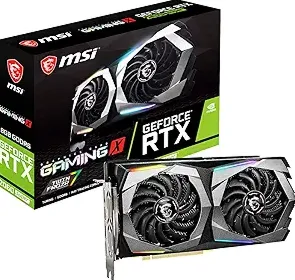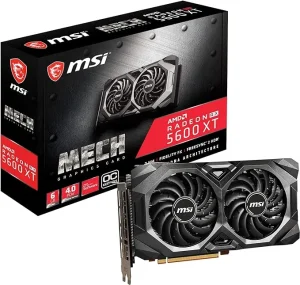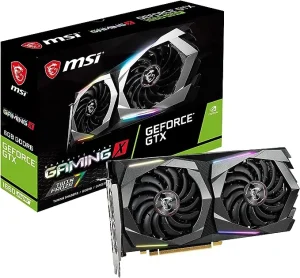5 Best graphics card for Ryzen 5 2600 in 2024
Looking for the best graphics card for your Ryzen 5 2600? Look no further! We’ve got you covered with this ultimate guide. Whether you’re a gaming enthusiast or a creative professional, finding the perfect graphics card to complement your Ryzen 5 2600 can make all the difference in your computing experience. Let’s dive in and explore the top options that will take your visuals to the next level!
5 Best graphics card for Ryzen 5 2600 in 2024
| Serial No. | Product Name | Check Price |
| 1 | NVIDIA GeForce GTX 1660 Ti | Check Price |
| 2 | AMD Radeon RX 5700 XT | Check Price |
| 3 | NVIDIA GeForce RTX 2060 Super | Check Price |
| 4 | AMD Radeon RX 5600 XT | Check Price |
| 5 | NVIDIA GeForce GTX 1660 Super | Check Price |
1. NVIDIA GeForce GTX 1660 Ti

| Specification | Value |
| VRAM | 6GB 192-Bit GDDR6 |
| Boost Clock | 1875 MHz |
| Ports | 1 x HDMI 2.0b, 3 x DisplayPort 1.4 |
| Interface | PCI Express 3.0 x16 |
| Cores | 1536 Units |
One of the standout features of the GTX 1660 Ti is its 6GB 192-bit GDDR6 VRAM, which ensures smooth and lag-free gaming experiences even on graphically demanding titles. With a boost clock of 1875 MHz, this card offers excellent speed and responsiveness, allowing for seamless gameplay and quick rendering of graphics.
In terms of connectivity, the GTX 1660 Ti comes equipped with 1 x HDMI 2.0b and 3 x DisplayPort 1.4 ports, providing ample options for connecting multiple displays or VR headsets. The PCI Express 3.0 x16 interface ensures a reliable and high-speed connection to your motherboard, maximizing data transfer rates.
The GTX 1660 Ti features 1536 units of cores, which contribute to its impressive performance and efficient power consumption. This balance allows for smooth multitasking and optimal utilization of your Ryzen 5 2600’s capabilities.
Now, let’s take a look at the pros and cons of the NVIDIA GeForce GTX 1660 Ti:
Pros:
- Excellent performance for its price range
- Efficient power consumption
- Smooth gaming experience on most modern titles
- Great value for money
- Compatible with Ryzen 5 2600
Cons:
- Not suitable for 4K gaming
- Limited VRAM capacity for more demanding applications
2. AMD Radeon RX 5700 XT

| Specification | Value |
| Base Clock | 1670 MHz |
| Game Clock | 1815 MHz |
| Boost Clock | 1925 MHz |
| Pcie Version | 4.0 |
| Operating System | Windows 10, Windows 7 64-bit |
| Power Supply Requirement | Recommended 650W, Minimum 600W |
| Power Connectors | 1 x 8-pin, 1 x 6-pin |
| Outputs | 1 x HDMI, 3 x DisplayPort |
| Cooling Technology | Dual-X Cooling |
The RX 5700 XT is a powerhouse that delivers exceptional performance and breathtaking visuals.
With a base clock of 1670 MHz, a game clock of 1815 MHz, and a boost clock of 1925 MHz, this graphics card offers blisteringly fast speeds, ensuring smooth gameplay and seamless rendering of high-quality graphics.
The PCIe 4.0 version ensures a high-bandwidth connection to your motherboard, maximizing data transfer rates.
When it comes to compatibility, the Radeon RX 5700 XT works seamlessly with Windows 10 and Windows 7 64-bit operating systems. It requires a minimum of 8 GB of system memory, but 16 GB is recommended for optimal performance. Additionally, you’ll need a PCI Express-based PC with a single X16 lane graphics slot available on the motherboard.
The power supply requirement is a recommended 650W, with a minimum of 600W, and it requires 1 x 8-pin and 1 x 6-pin power connectors.
The RX 5700 XT boasts 4 outputs, including 1 x HDMI and 3 x DisplayPort, allowing for multiple display setups or connectivity with VR headsets. The card’s dual-X cooling technology ensures efficient heat dissipation, keeping the GPU cool even during intense gaming sessions.
Now, let’s take a look at the pros and cons of the AMD Radeon RX 5700 XT:
Pros:
- Exceptional performance for demanding games
- Stunning visuals and smooth gameplay
- PCIe 4.0 for high-bandwidth connection
- Compatible with Ryzen 5 2600
- Dual-X cooling technology for efficient heat dissipation
Cons:
- Can run hot under heavy load
- Requires a higher power supply compared to some other graphics cards
3. NVIDIA GeForce RTX 2060 Super

| Specification | Value |
| GPU Architecture | NVIDIA Turing |
| Graphics Card Model | NVIDIA GeForce RTX 2060 SUPER |
| Boost Clock | 1695 MHz |
| Video Memory | 8GB GDDR6 |
| Memory Interface | 256-bit |
| Outputs | 3 x DisplayPort v1.4, 1 x HDMI 2.0b |
| Cooling Technology | MSI TWIN-FROZR |
| Zero Frozr Technology | Yes |
| RGB Lighting | MSI Mystic Light |
One of the standout features of this graphics card is its memory interface. With a 256-bit memory interface, the RTX 2060 Super provides high-speed data transfer and efficient handling of large textures and complex scenes, resulting in stunning visuals and breathtaking details.
In terms of connectivity, the RTX 2060 Super offers three DisplayPort v1.4 outputs and one HDMI 2.0b output, allowing for multiple display setups or connections to high-resolution monitors. This versatility ensures that you can enjoy your games on a variety of screens with ease.
When it comes to cooling, the RTX 2060 Super is equipped with MSI TWIN-FROZR technology, providing high-performance cooling and style. This cooling solution keeps the graphics card’s temperature in check, ensuring optimal performance even during intense gaming sessions. Additionally, the Zero Frozr Technology featured in this card stops the fans in low-load situations, eliminating noise and creating a quieter gaming environment.
To add a touch of personalization, the NVIDIA GeForce RTX 2060 Super is compatible with MSI Mystic Light. With the Dragon Center software, you can customize colors and LED effects, synchronizing them with other compatible components in your system. This allows you to create a visually stunning and cohesive gaming setup that reflects your unique style.
Now, let’s take a look at the pros and cons of the NVIDIA GeForce RTX 2060 Super:
Pros:
- Exceptional performance and realistic visuals
- High-speed data transfer with a 256-bit memory interface
- Versatile connectivity with multiple display outputs
- MSI TWIN-FROZR cooling technology for efficient heat dissipation
- Zero Frozr Technology for a quieter gaming experience
- Customizable RGB lighting with MSI Mystic Light
Cons:
- May be slightly pricier compared to some other graphics cards in its segment
4. AMD Radeon RX 5600 XT

| Specification | Value |
| GPU Architecture | AMD RDNA |
| Graphics Card Model | AMD Radeon RX 5600 XT |
| Boost Clock | 1600 MHz |
| Video Memory | 6GB GDDR6 |
| Memory Interface | 192-bit |
| Outputs | 3 x DisplayPort v1.4, 1 x HDMI 2.0b |
This graphics card delivers exceptional performance and stunning visuals that enhance your gaming experience. With a boost clock of 1600 MHz and 6GB of GDDR6 video memory, the RX 5600 XT ensures smooth gameplay and seamless rendering of high-resolution graphics.
The 192-bit memory interface of the RX 5600 XT allows for efficient data transfer and handling of complex textures and scenes, resulting in sharp and detailed visuals. Whether you’re exploring vast open worlds or engaging in fast-paced multiplayer battles, this graphics card keeps up with the demands of modern gaming.
In terms of connectivity, the RX 5600 XT offers three DisplayPort v1.4 outputs and one HDMI 2.0b output, allowing for multiple display setups or connections to high-resolution monitors. This versatility ensures that you can enjoy your games on a variety of screens with ease.
Now let’s take a look at the pros and cons of the AMD Radeon RX 5600 XT:
Pros:
- Exceptional performance and stunning visuals
- Smooth gameplay with 1600 MHz boost clock
- Efficient data transfer with a 192-bit memory interface
- Versatile connectivity with multiple display outputs
- Great value for the performance it offers
Cons:
- Limited video memory compared to some other graphics cards in its segment
5. NVIDIA GeForce GTX 1660 Super

| Specification | Value |
| GPU Architecture | NVIDIA Turing |
| Graphics Card Model | NVIDIA GeForce GTX 1660 Super |
| Boost Clock | 1830 MHz |
| Video Memory | 6GB GDDR6 |
| Memory Interface | 192-bit |
| Outputs | 3 x DisplayPort v1.4, 1 x HDMI 2.0b |
This graphics card delivers exceptional performance and breathtaking visuals that enhance your gaming experience. With a boost clock of 1830 MHz and 6GB of GDDR6 video memory, the GTX 1660 Super ensures smooth gameplay and stunning graphics.
The 192-bit memory interface of the GTX 1660 Super allows for efficient data transfer, enabling the card to handle demanding games and applications with ease. Whether you’re exploring vast open worlds or engaged in fast-paced multiplayer battles, this graphics card keeps up with the demands of modern gaming, delivering crisp and detailed visuals.
In terms of connectivity, the GTX 1660 Super offers three DisplayPort v1.4 outputs and one HDMI 2.0b output, allowing for multiple display setups or connections to high-resolution monitors. This versatility ensures that you can enjoy your games on various screens without any hassle.
Now let’s take a look at the pros and cons of the NVIDIA GeForce GTX 1660 Super:
Pros:
- Exceptional performance and breathtaking visuals
- Smooth gameplay with a boost clock of 1830 MHz
- Efficient data transfer with a 192-bit memory interface
- Versatile connectivity with multiple display outputs
- Great value for the performance it offers
Cons:
- Limited video memory compared to some other graphics cards in its range
Buying Guide: 6 Factors to Consider When Choosing a Graphics Card for Ryzen 5 2600
Choosing the right graphics card for your Ryzen 5 2600 can significantly enhance your gaming experience. With so many options available in the market, it’s essential to consider certain factors to ensure you make the best choice. In this buying guide, I’ll walk you through six crucial factors to consider when selecting a graphics card that perfectly complements your Ryzen 5 2600.
Compatibility: Before diving into the specifications, it’s crucial to ensure the graphics card you choose is compatible with your Ryzen 5 2600. Check the motherboard’s PCIe slot compatibility and power supply requirements to ensure a seamless integration.
Performance: Consider the performance capabilities of the graphics card. Look for factors such as clock speed, memory type, memory interface, and number of CUDA cores. These specifications directly impact the card’s ability to handle modern games and applications smoothly.
Budget: Set a budget for your graphics card purchase. Determine the maximum amount you’re willing to spend and consider options within that range. It’s essential to strike a balance between performance and cost to get the best value for your money.
Power Consumption: Graphics cards can consume a significant amount of power. Ensure that your power supply unit (PSU) can handle the power requirements of the graphics card you choose. It’s crucial to have a PSU with sufficient wattage and the necessary power connectors.
Cooling and Noise: Graphics cards can generate heat during intensive gaming sessions. Look for graphics cards with effective cooling solutions such as dual or triple fans, heat pipes, or liquid cooling. Additionally, consider the noise levels generated by the cooling system to ensure a quieter gaming experience.
Future Upgradability: Consider your future plans for upgrading your system. If you foresee upgrading your CPU or other components in the near future, choose a graphics card that will still be compatible with those upgrades.
This ensures that you won’t need to replace the graphics card when you upgrade other parts of your system.
Based on the factors mentioned above, I would suggest considering the NVIDIA GeForce GTX 1660 Super or the AMD Radeon RX 5600 XT. Both these graphics cards offer excellent performance and are compatible with the Ryzen 5 2600.
They also provide a good balance between performance and cost, making them ideal choices for gamers on a budget.
FAQ’s
1. Can I use any graphics card with my Ryzen 5 2600?
No, you need to ensure compatibility between the graphics card and your motherboard’s PCIe slot. Additionally, check the power supply requirements of the graphics card to ensure your PSU can handle it.
2. Is it necessary to overclock my Ryzen 5 2600 to make the most of a high-end graphics card?
While overclocking can provide a performance boost, it’s not necessary to enjoy the benefits of a high-end graphics card. The Ryzen 5 2600 can handle most modern graphics cards without overclocking.
3. Should I prioritize a graphics card with more VRAM for my Ryzen 5 2600?
While VRAM is important, it’s not the sole determinant of a graphics card’s performance. Consider other factors such as clock speed, memory interface, and CUDA cores to assess overall performance.
4. Will a high-end graphics card put excessive strain on my power supply unit (PSU)?
It’s important to check the power requirements of the graphics card and ensure your PSU has sufficient wattage and the necessary power connectors. Upgrading to a higher-wattage PSU may be necessary for some high-end graphics cards.
5. Can I upgrade my graphics card in the future if I choose a specific model for my Ryzen 5 2600?
Yes, you can upgrade your graphics card in the future, but it’s important to consider factors such as compatibility and power supply requirements when choosing a graphics card initially. Ensure your future upgrades will still be compatible with your chosen graphics card.
Conclusion
Choosing the best graphics card for your Ryzen 5 2600 is an exciting endeavor that can greatly enhance your gaming experience. By considering factors such as compatibility, performance, budget, power consumption, cooling, and future upgradability, you can make an informed decision that suits your specific needs and preferences.
Remember, finding the perfect graphics card is all about striking a balance between performance and cost, ensuring seamless integration with your Ryzen 5 2600, and providing an immersive gaming experience. Happy gaming!
